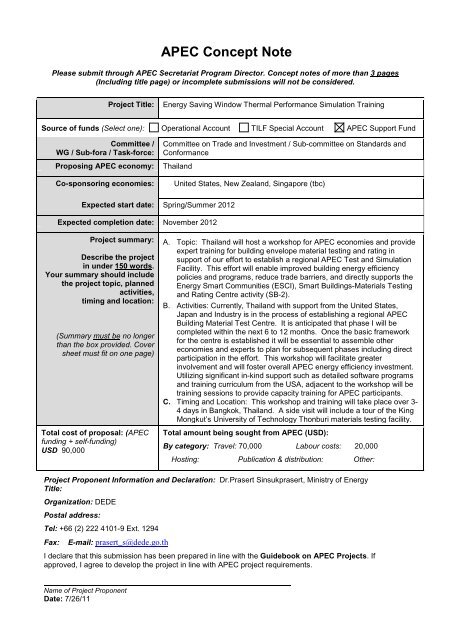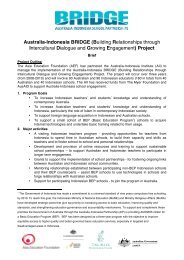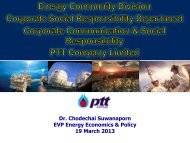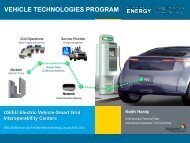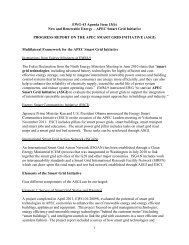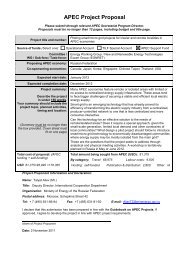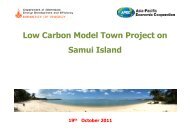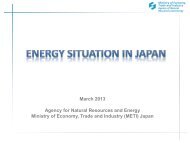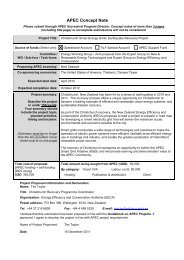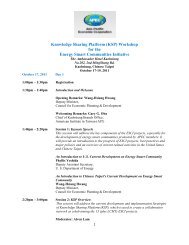APEC Building Material Workshop and Training ... - ESCI KSP
APEC Building Material Workshop and Training ... - ESCI KSP
APEC Building Material Workshop and Training ... - ESCI KSP
You also want an ePaper? Increase the reach of your titles
YUMPU automatically turns print PDFs into web optimized ePapers that Google loves.
<strong>APEC</strong> Concept NotePlease submit through <strong>APEC</strong> Secretariat Program Director. Concept notes of more than 3 pages(Including title page) or incomplete submissions will not be considered.Project Title:Energy Saving Window Thermal Performance Simulation <strong>Training</strong>Source of funds (Select one): Operational Account TILF Special Account <strong>APEC</strong> Support FundCommittee /WG / Sub-fora / Task-force:Proposing <strong>APEC</strong> economy:Co-sponsoring economies:Committee on Trade <strong>and</strong> Investment / Sub-committee on St<strong>and</strong>ards <strong>and</strong>ConformanceThail<strong>and</strong>United States, New Zeal<strong>and</strong>, Singapore (tbc)Expected start date: Spring/Summer 2012Expected completion date: November 2012Project summary:Describe the projectin under 150 words.Your summary should includethe project topic, plannedactivities,timing <strong>and</strong> location:(Summary must be no longerthan the box provided. Coversheet must fit on one page)Total cost of proposal: (<strong>APEC</strong>funding + self-funding)USD 90,000A. Topic: Thail<strong>and</strong> will host a workshop for <strong>APEC</strong> economies <strong>and</strong> provideexpert training for building envelope material testing <strong>and</strong> rating insupport of our effort to establish a regional <strong>APEC</strong> Test <strong>and</strong> SimulationFacility. This effort will enable improved building energy efficiencypolicies <strong>and</strong> programs, reduce trade barriers, <strong>and</strong> directly supports theEnergy Smart Communities (<strong>ESCI</strong>), Smart <strong>Building</strong>s-<strong>Material</strong>s Testing<strong>and</strong> Rating Centre activity (SB-2).B. Activities: Currently, Thail<strong>and</strong> with support from the United States,Japan <strong>and</strong> Industry is in the process of establishing a regional <strong>APEC</strong><strong>Building</strong> <strong>Material</strong> Test Centre. It is anticipated that phase I will becompleted within the next 6 to 12 months. Once the basic frameworkfor the centre is established it will be essential to assemble othereconomies <strong>and</strong> experts to plan for subsequent phases including directparticipation in the effort. This workshop will facilitate greaterinvolvement <strong>and</strong> will foster overall <strong>APEC</strong> energy efficiency investment.Utilizing significant in-kind support such as detailed software programs<strong>and</strong> training curriculum from the USA, adjacent to the workshop will betraining sessions to provide capacity training for <strong>APEC</strong> participants.C. Timing <strong>and</strong> Location: This workshop <strong>and</strong> training will take place over 3-4 days in Bangkok, Thail<strong>and</strong>. A side visit will include a tour of the KingMongkut’s University of Technology Thonburi materials testing facility.Total amount being sought from <strong>APEC</strong> (USD):By category: Travel: 70,000 Labour costs: 20,000Hosting: Publication & distribution: Other:Project Proponent Information <strong>and</strong> Declaration: Dr.Prasert Sinsukprasert, Ministry of EnergyTitle:Organization: DEDEPostal address:Tel: +66 (2) 222 4101-9 Ext. 1294Fax:E-mail: prasert_s@dede.go.thI declare that this submission has been prepared in line with the Guidebook on <strong>APEC</strong> Projects. Ifapproved, I agree to develop the project in line with <strong>APEC</strong> project requirements.Name of Project ProponentDate: 7/26/11
Project Synopsis1. Relevance: Why should <strong>APEC</strong> undertake this project? What problem or opportunity will theproject address <strong>and</strong> why is it important?<strong>Building</strong>’s are responsible for approximately 50 per cent of the electricity consumption in most<strong>APEC</strong> economies. Space conditioning loads that are directly affected by the building envelope(window, walls, roof <strong>and</strong> foundation) characteristics are responsible for approximately 30 to 50 percent of the building consumption. Thus, in order to curtail the growth of increased dem<strong>and</strong> forelectricity, investment in high performance building envelopes is essential. This project directlyaddresses this opportunity in a way that is most effective.In 2010, <strong>APEC</strong> leaders acknowledged the importance of work on st<strong>and</strong>ards <strong>and</strong> conformance toreduce the impact of non-tariff barriers on free <strong>and</strong> open trade <strong>and</strong> investment. Leaders alsoemphasized that innovative growth should be advanced across <strong>APEC</strong> economies through theadoption of policies that best enable economies to support innovation <strong>and</strong> use information <strong>and</strong>communication technologies. This project directly supports these goals by seeking to promote abuilding envelope energy rating harmonization effort among <strong>APEC</strong> economies based on provenenergy ratings systems. This effort will educate other <strong>APEC</strong> economies on how to perform widelyaccepted energy efficiency practices to ensure implementation <strong>and</strong> enforcement of buildingenergy codes.The <strong>APEC</strong> Energy Saving Window Study, completed for <strong>APEC</strong> by the National FenestrationRating Council in 2011, revealed a lack of congruent building envelope energy efficient practicesamong <strong>APEC</strong> economies including very limited window energy rating procedures. This projectproposes to follow up on this study’s recommendations to educate <strong>APEC</strong> economies on state-ofthe-artenergy efficient window rating procedures that comply with internationally recognizedst<strong>and</strong>ards. Currently, most building energy codes make a general reference to window energyperformance leading to widely divergent results reducing building energy savings. Fundamentalinvestments for insulation applications, cool roof technologies, <strong>and</strong> other technologicalopportunities need to be pursued by all <strong>APEC</strong> economies <strong>and</strong> are included in the scope of thisproject.2. Objectives: Describe the 2-3 key objectives of the project. (e.g. to... create a framework...;ensure participants will be able to...; share experiences...; enhance underst<strong>and</strong>ing...;develop recommendations...; build interest...; revise strategies... etc.)• Collaborate working on an <strong>APEC</strong> pilot test case that can be replicated throughout<strong>APEC</strong> by participating in the establishment of the first <strong>APEC</strong> regional energyefficient testing <strong>and</strong> rating center, where building envelope energy savingopportunities will be taught <strong>and</strong> implemented• Revise <strong>APEC</strong> economy building energy saving strategies to include internationallyrecognized energy saving ratings methods• Basic capacity building <strong>and</strong> sharing of <strong>APEC</strong> economy building envelope energysavings successes3. Alignment: Describe how the project will help achieve <strong>APEC</strong>’s key priorities <strong>and</strong> meet yourforum’s work-plan or medium-term plan.This project directly supports the 2010 <strong>APEC</strong> Leaders decision to implement the Energy SmartCommunities Initiative (<strong>ESCI</strong>) for the <strong>APEC</strong> <strong>Building</strong> <strong>Material</strong> Testing <strong>and</strong> Rating Center (SB2).This project is directly focused on test st<strong>and</strong>ard development <strong>and</strong> harmonization to fostereconomic growth of energy efficient technologies <strong>and</strong> to reduce trade barriers.This workshop <strong>and</strong> training session will be a major effort to get greater support from the <strong>APEC</strong>region. In 2011, under a self-funded US led project, a first successful workshop was held <strong>and</strong> sixeconomies participated. Significant momentum has been created, however this next workshopwill be held at a critical time when the test center will be moving towards phase II. Getting greatersupport from multiple <strong>APEC</strong> economies for participation <strong>and</strong> recognition, will help secure fundingfrom the private sector since many companies serve numerous <strong>APEC</strong> markets. Fundingrequirements for phase II will be much greater <strong>and</strong> a consolidated <strong>APEC</strong> effort as proposed forthis project can make a big difference in securing the private sector investment.
4. Methodology: How do you plan to implement the project? In this section, address:• Timeline: Project timelines <strong>and</strong> dates for key activities <strong>and</strong> deliverables• Identify workshop participants <strong>and</strong> extend invitation to training seminar (February 2012to April 2012)• Coordinate workshop <strong>and</strong> training at a regional energy efficiency center, likely inBangkok, Thail<strong>and</strong> (April 2012 to May 2012)• Host workshop <strong>and</strong> training over three to four days, timing highly dependent upon theplans <strong>and</strong> development of phase I for the test center establishment (hosted betweenJune 2012 – Oct 2012)• Summary of workshop completion with action items, next steps, <strong>and</strong> revisedimplementation plan (30 days after workshop)• Posting of all materials <strong>and</strong> final report from the workshop on the internet for easyaccess by all <strong>APEC</strong> economies.• Stakeholders: Beneficiaries <strong>and</strong> stakeholders (<strong>APEC</strong> & non-<strong>APEC</strong>) <strong>and</strong> how they will beengaged• <strong>APEC</strong> economy building material manufacturers, industry experts, academics,governmental officials (energy code officials), <strong>and</strong> product suppliers will makepresentations <strong>and</strong> engage in discussion forums• Non <strong>APEC</strong> fenestration manufacturers <strong>and</strong> suppliers providing products to <strong>APEC</strong>economies may participate• Residential <strong>and</strong> commercial building owners/tenants will learn about newopportunities to reduce energy consumption, <strong>and</strong> gain increased comfort forunconditioned buildings thus avoid increased space conditioning loads that come withincreased income• <strong>APEC</strong> policy developers will learn how product ratings can help in establishing arange of energy efficiency policies; participation will be pursued so that “buy-In” canbe achieved leading to program requirements that specify the need for ratedperformance of complying products.• Previous projects/activities: If <strong>and</strong> how this proposal builds on the findings or lessonslearned from previous projects/activities, while avoiding duplication• This project will build upon NFRC’s recent <strong>APEC</strong> supported research titled: EnergySaving Windows- Survey of Policies <strong>and</strong> Programs to Promote Advanced Window<strong>and</strong> Glazing Technologies in <strong>APEC</strong> Economies. This research highlighted thetremendous need for improved building energy policies <strong>and</strong> programs where energysaving windows may be further implemented by providing an energy rating methodsuch as that proposed here.• Click here to access the paper: http://publications.apec.org/publicationdetail.php?pub_id=1172• This project also builds upon the outcome of the Cooperative Energy EfficiencyDesign for Sustainability (CEEDS) Phase II effort on <strong>Building</strong> Energy Codes lead bythe Asia Pacific Energy Research Centre.• Communication: How you plan to communicate the results or benefits of this project toothers• The results of the workshop will be made available in the public domain. Policydevelopers from organizing economies including Thail<strong>and</strong>, USA <strong>and</strong> Japan willpromote the effort to other economies <strong>and</strong> within entities within their own economies.Global material suppliers will promote the effort to developing markets in other <strong>APEC</strong>economies. The entire effort will become a major case study to be replicated in othereconomies.


